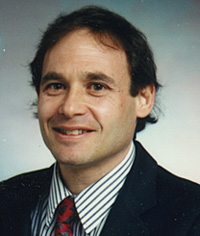Feature
Peter Siegel: Studying the Energy of the Universe
07.08.04

|
Image to right: NASA Scientist Peter Siegel hopes to map the entire upper atmosphere from the vantage point of space using their THz sensors aboard Aura. Credit: NASA
At least 98 percent of the detectable radiant energy in the universe falls within the THz, or far-infrared part of the electromagnetic spectrum -- a band of long wavelengths outside our range of visible light.
Your chemistry book has a table of metric system prefixes. Take a look, and you'll see that "tera" stands for 1 trillion. Hertz is a frequency unit that stands for waves, or cycles, per second. That means THz radiation has frequencies of about 1 trillion hertz -- a trillion cycles per second -- and a corresponding wavelength of less than one millimeter.
A trillion sounds enormous, but THz is pretty middle-of-the-road when it comes to electromagnetic radiation. Although the frequency of THz is 1,000 times higher than that of the energy zapping your food in a microwave, it lies well below the frequency of the infrared radiation emitted from the person sitting next to you.
THz radiation is not easily observed on Earth. The larger amounts of radiant energy emitted by warmer objects makes it difficult to detect the weaker amounts of energy given off by cooler objects. In addition, water and oxygen in the atmosphere absorb THz energy, so much so that the signal from a strong THz source drops to zero just a few meters away.
As a result, we're missing out on some fascinating observations of planets like Venus, Mars and Jupiter; satellites like Europa and Titan; comets and asteroids; gaseous regions of interstellar space where new stars form; and gas, dust and stars in other galaxies. Last but not least, we're missing some important information about our own atmosphere.
Terahertz Reveals What's in the Air
Siegel heads up a group of more than 20 scientists and engineers specializing in terahertz technology at NASA's Jet Propulsion Laboratory in Pasadena, California. Siegel points out that there are strong THz sources in our upper atmosphere, such as the hydroxide radical, hydrogen chloride and water, which can tell us much about the chemical processes that govern the ozone cycle and global warming. Unfortunately, it's virtually impossible to detect this radiation by looking up through the atmosphere from the ground because most of it is absorbed by water and oxygen in the lower atmosphere.
What little we do know about THz sources in the upper atmosphere has come from measurements made at observatories at the tops of mountains, at the South Pole (which is both high and very dry), and by high-flying aircraft and high-altitude helium balloons. Siegel's group looks forward to being able to continually map the entire upper atmosphere from the vantage point of space using their THz sensors aboard Aura. Aura, with its anticipated long-term global coverage, offers the best opportunity to date for deploying such technology.
THz and other sensors on Aura will be used to determine the presence and distribution of a wide range of atmospheric constituents, including water vapor, chlorine monoxide, sulfur dioxide, hydrogen chloride and the hydroxyl radical -- molecules that directly and indirectly affect the quality of life on Earth. As a group, these and other molecules are involved in stratospheric ozone destruction, thus impacting long-term climate changes, such as global warming.
A Fascination Inspired by the Moon Race
Siegel's interest in science goes back to his high school days. Inspired by a love of science fiction, he describes himself as a "product of the 1960s moon race" -- that exciting time when the decades-long dreams of amateur astronomers and space enthusiasts of all ages finally came true as Neil Armstrong placed the first human footprint on the moon in July 1969.
Although the demands of his profession leave little time to spare, Siegel still likes to do some woodworking, along with tropical fish keeping, ham radio operating and scuba diving.
Maintaining that he is not gifted with a "superior intelligence," he attributes his success to the passion he has for his work. According to him, "There is nothing that competes with the feeling you get when after hours, days, weeks or even years of work on a problem, you get the answer -- even if it's not the one you expected!"
Edited by Dan Stillman, Institute for Global Environmental Strategies